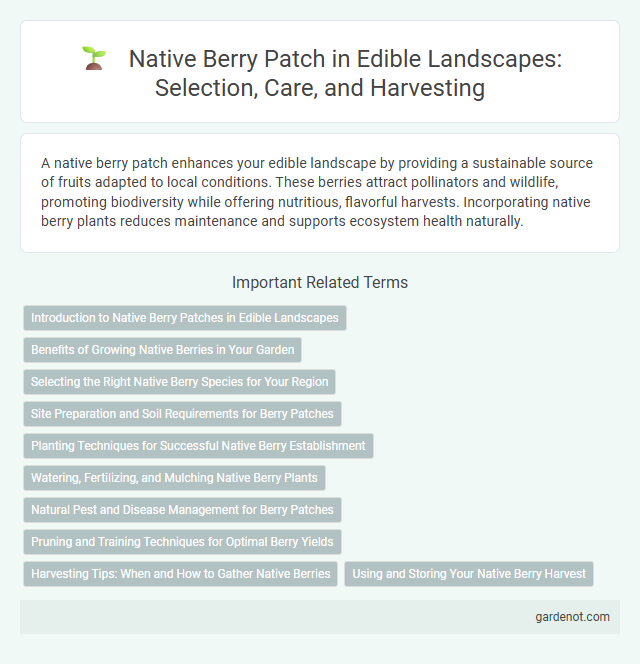A native berry patch enhances your edible landscape by providing a sustainable source of fruits adapted to local conditions. These berries attract pollinators and wildlife, promoting biodiversity while offering nutritious, flavorful harvests. Incorporating native berry plants reduces maintenance and supports ecosystem health naturally.
Introduction to Native Berry Patches in Edible Landscapes
Native berry patches enhance edible landscapes by providing a sustainable source of nutrient-rich fruits while supporting local ecosystems. These patches often include species such as elderberry, black raspberry, and serviceberry, which thrive in regional climates and require minimal maintenance. Incorporating native berries promotes biodiversity, attracts beneficial pollinators, and offers a natural, organic harvest throughout the growing season.
Benefits of Growing Native Berries in Your Garden
Growing native berries like elderberries, blueberries, and serviceberries enriches soil health through natural nutrient cycling and supports local pollinators, enhancing garden biodiversity. These berries are well-adapted to regional climate and pest resistance, reducing the need for chemical interventions and conserving water. Cultivating native berry patches also provides nutrient-dense, antioxidant-rich fruits that contribute to food security and promote sustainable, eco-friendly landscaping.
Selecting the Right Native Berry Species for Your Region
Selecting the right native berry species for your region ensures optimal growth and sustainability in an edible landscape. Consider factors such as soil type, climate zone, and local wildlife interactions to choose species like elderberry for wetter areas, serviceberry for colder climates, or beach plum for coastal zones. Incorporating region-specific native berries enhances biodiversity while providing nutrient-rich fruits suited to your landscape's natural conditions.
Site Preparation and Soil Requirements for Berry Patches
Native berry patches thrive in well-drained, loamy soils rich in organic matter, with a pH level between 5.5 and 6.5 to optimize nutrient availability. Site preparation involves clearing invasive species, loosening compacted soil, and incorporating compost or aged manure to enhance soil fertility and moisture retention. Establishing native berry plants in a location that receives full sun to partial shade supports robust growth and fruit production.
Planting Techniques for Successful Native Berry Establishment
Successful native berry patch establishment relies on selecting disease-resistant, local berry species such as Vaccinium, Rubus, or Sambucus that thrive in specific soil pH and climate conditions. Incorporate organic matter to improve soil texture and moisture retention while ensuring proper spacing to enhance air circulation and reduce fungal risks. Mulching with native materials protects young plants, conserves water, and suppresses weeds, promoting vigorous root development and long-term productivity.
Watering, Fertilizing, and Mulching Native Berry Plants
Native berry plants thrive with consistent watering, especially during dry periods, ensuring the soil remains moist but not waterlogged. Fertilizing with organic compost or slow-release fertilizers rich in nitrogen and potassium supports robust growth and berry production. Mulching with natural materials like wood chips or straw helps retain soil moisture, regulate temperature, and suppress weeds around native berry patches.
Natural Pest and Disease Management for Berry Patches
Native berry patches thrive with integrated pest management strategies that emphasize natural predators such as ladybugs and predatory mites to control common pests like aphids and spider mites. Utilizing companion planting with herbs like basil and marigold enhances pest deterrence while promoting pollinator attraction, which boosts fruit yield without chemical intervention. Implementing organic mulches and optimizing soil health encourage beneficial microbial activity, reducing disease incidence and supporting robust berry plant growth.
Pruning and Training Techniques for Optimal Berry Yields
Pruning and training native berry patches, such as those with elderberries or huckleberries, significantly enhance fruit production by promoting healthy growth and improving air circulation. Focus on removing dead or overcrowded branches early in the growing season to stimulate vigorous new shoots and increase sunlight penetration, essential for ripening berries. Employing trellising or staking supports can guide growth, prevent sprawling, and facilitate easier harvesting while maximizing yield in edible landscapes.
Harvesting Tips: When and How to Gather Native Berries
Harvest native berries in the early morning when they are cool and firm to preserve freshness and flavor. Gently pluck ripe berries by hand, avoiding unripe or damaged fruit to ensure plant health and promote continual growth. Use shallow containers for collection to prevent crushing and maintain berry quality during transport.
Using and Storing Your Native Berry Harvest
Native berry patches produce nutrient-dense fruits rich in antioxidants and vitamins, ideal for fresh eating or incorporating into jams, jellies, and baked goods. Harvested berries should be gently washed, dried, and stored in airtight containers to extend shelf life, or frozen for long-term preservation without losing flavor or nutritional value. Proper storage techniques prevent spoilage and ensure you can enjoy the health benefits of native berries throughout the year.
Native berry patch Infographic

 gardenot.com
gardenot.com